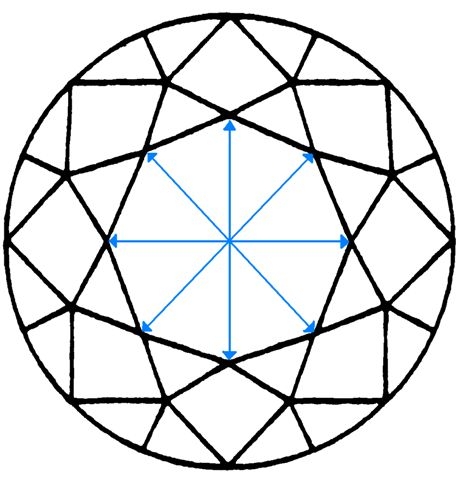Table size refers to the measurement of the table facet of a diamond, which is the large, flat surface located on the top of the stone. It is expressed as a percentage of the diameter of the diamond. The table size is a crucial factor in determining the overall appearance and brilliance of the diamond. It plays an essential role in balancing brilliance (the white light reflected from the diamond) and dispersion (the colourful flashes of light that come from the diamond’s facets).
Table Size and its Impact on Brilliance and Fire:
Brilliance: A well-proportioned table allows for an optimal amount of light to enter the diamond, reflect off the facets inside, and return to the viewer’s eye. The table size is an essential factor that helps to achieve maximum brilliance. When the table is too large, more light may leak out from the bottom of the diamond, reducing brilliance. A table that is too small may limit light reflection, resulting in a dull appearance.
Dispersion (Fire): Dispersion is the colourful flashes of light that a diamond emits when it is moved or viewed under direct light. The table size also affects how much dispersion is visible. A properly proportioned table will allow for the best balance between brilliance (white light) and fire (colourful flashes). If the table size is too large, it may decrease the intensity of the dispersion, as the light may not be effectively refracted and split into different colours.
How Table Size is Measured:
Table Size as a Percentage: Table size is typically expressed as a percentage, representing the diameter of the table facet in relation to the overall diameter of the diamond. For example, if the table diameter is 5mm and the overall diameter of the diamond is 8mm, the table size would be calculated as:
Table Size Percentage
Table Size Percentage=(85)×100=62.5%
This means the table facet makes up 62.5% of the total diameter of the diamond.
Ideal Table Size:
For round brilliant cut diamonds, the ideal table size typically falls within the 53% to 58% range of the diamond’s total diameter. This proportion allows for the best balance of light reflection and brilliance, ensuring the diamond appears vibrant and sparkling. When the table is within this ideal range, it enhances the diamond’s overall performance by optimising how it handles light.
Ideal Range: A table size between 53% and 58% is generally considered ideal for round brilliant cut diamonds. Diamonds with table sizes within this range tend to exhibit excellent brilliance and light performance.
Larger Table Sizes: A table size that is larger than 58% may reduce the amount of light that is reflected, resulting in lower brilliance. This can make the diamond appear flat and less lively.
Smaller Table Sizes: A table size smaller than 53% may limit the amount of light that enters the diamond, reducing its sparkle and making the diamond look darker or duller.
Table Size and Diamond Grading:
The table size is one of the factors assessed when determining the cut grade of a diamond, particularly in round brilliant cut diamonds. The cut grade reflects the overall quality of the diamond’s proportions, symmetry, and polish, and it has a significant impact on the diamond’s brilliance and value.
Proportions: Table size is a crucial part of the overall proportions of a diamond, and it works in conjunction with other factors such as crown angle, pavilion depth, and girdle thickness to determine the overall quality of the cut.
Diamond Certification: Leading diamond grading laboratories, such as the DCLA (Diamond Certification Laboratory of Australia), carefully assess the table size when providing a grading report. They ensure that the table size falls within an acceptable range for the diamond’s shape and type to guarantee the best possible visual performance.
Fancy-Shaped Diamonds and Table Size:
While table size is most commonly associated with round brilliant cut diamonds, it also applies to other fancy-shaped diamonds, such as emerald cut, asscher cut, princess cut, and oval cut diamonds. However, for fancy shapes, the ideal table size may vary depending on the shape and the proportions of the diamond. For example:
Princess Cut Diamonds: In a princess cut diamond, the table size is usually larger relative to the overall size, often in the 60% to 70% range. This helps to achieve the maximum brilliance and visual appeal.
Emerald Cut Diamonds: Due to their step-cut faceting, emerald cut diamonds tend to have a larger table relative to their overall size, often ranging from 60% to 70% as well. The larger table enhances the clarity of the diamond, allowing the observer to better appreciate its internal characteristics.
Factors Affecting Table Size:
Several factors can influence the size of the table facet on a diamond:
Cutting Style: The cutting style of the diamond affects the table size. Round brilliant cuts are often cut with a smaller table, while other cuts like princess and emerald may have larger tables.
Diamond Size: Larger diamonds often have larger table sizes, as their proportions allow for more substantial table facets without sacrificing the diamond’s brilliance.
Manufacturer Preferences: Some diamond manufacturers may adjust the table size to meet specific aesthetic or performance goals, influencing the final appearance of the diamond.
The table size of a diamond is a crucial factor that significantly influences its brilliance and fire. It is measured as a percentage of the diamond’s overall diameter, and its proper proportion ensures the diamond displays optimal light performance. For round brilliant cut diamonds, the ideal table size typically falls within the 53% to 58% range, although fancy-shaped diamonds may have varying table sizes depending on their unique cutting styles. Properly balanced table size, along with other critical cut factors, contributes to a diamond’s overall beauty, value, and appeal. The DCLA and other leading certification labs evaluate table size as part of the comprehensive cut grading process, ensuring that the diamond performs to its fullest potential.
